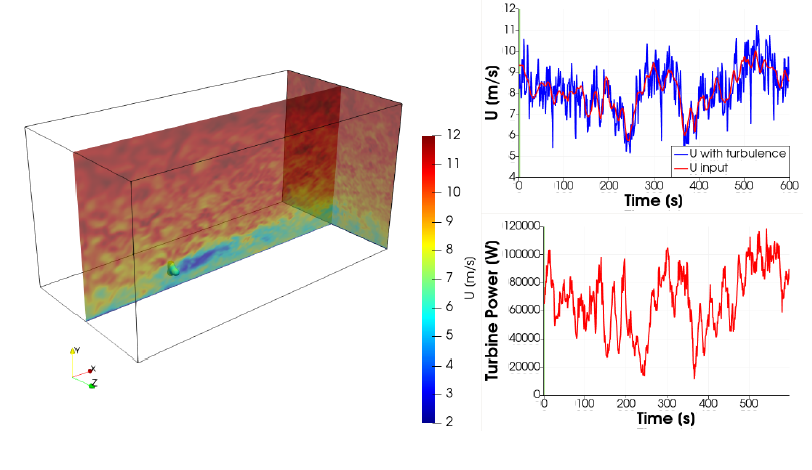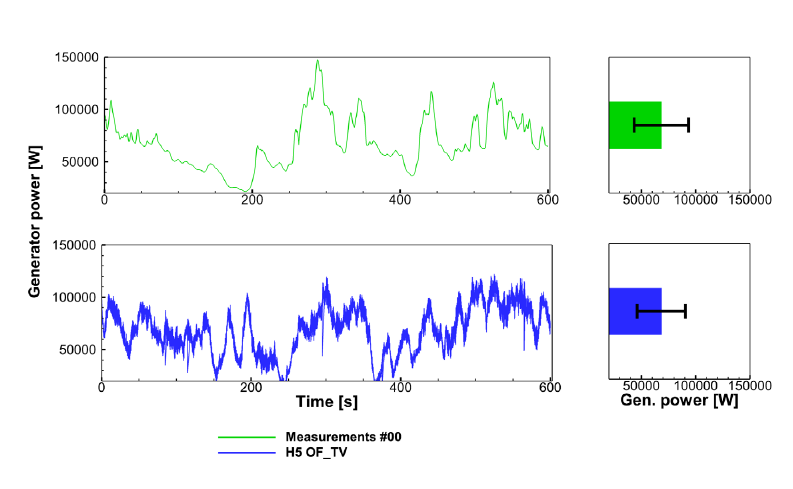Knowing that wind turbine and wind farm dynamics range in length scales, we used algorithms focused on these varying aspects to study the impact that flow dynamics have on wind turbines, blades and wind farms. Our High Performance Computing for Wind Energy (HPCWE) project addresses the development of algorithms for large-eddy simulations — a technique for simulating turbulent flows with high fidelity — to show the fluid-structure interaction (FSI) and aeroelastic coupling of wind turbine blades. By studying FSI, we are able to observe the interaction between a flexible structure and the fluid flow stream. Our research team also examined the development of wind turbine modelling methods for wind turbines and wind farms. This was accomplished by using mesoscale weather prediction models to generate the input data for the large-eddy simulations. Our final results discuss the development of uncertainty quantification (UQ) methods to determine how likely a certain outcome is if particular aspects are not known when processing complex data at high speeds — also known as high-performance computing environments (HPCE). We utilised the HPCE data to examine which parameters have the most significant influence on wind turbine performance.
This part of the HPCWE project was a collaboration between the University of Twente, the University of Stuttgart and the University of São Paulo. Our research teams re-evaluated the guidelines for the actuator line model simulations by comparing the results from three different LES codes with blade element momentum theory to calculate the local forces on wind turbine rotors. By performing cross-comparisons between the codes, we were able to implement necessary corrections and optimisations. All performance improvements were measured using KPIs (Key Perfomance Indicators) to provide better efficiency, accuracy and data reduction. Previous work shows that the distance between blade elements normalized by the grid size (Δblade/Δgrid) needs to be sufficiently high to achieve accurate outcomes. However, while evaluating our results, we found that the number of actuator points is less significant for accurately capturing a wind turbine’s thrust and power than reported in the past. In fact, using a Δblade/Δgrid ≤3 grid does not significantly improve the quality of the result. Previous guidelines suggested that utilising a Δblade/Δgrid <1.5 yielded the most optimal results.1 Thus, our findings indicate that the number of actuator points can be reduced — despite previous guidelines suggesting otherwise — without affecting or diminishing the accuracy of the wind turbine blades calculation. In regard to relevancy, these findings are applicable when the actuator line model is employed in large-scale computations where actuator line model calculations — which are local in space — result in significant computational overhead.
Additionally, we can use numerical simulations of turbulent flows to evaluate a turbine’s overall effectiveness. However, achieving these predictive simulations is difficult.
Today’s wind turbines have a large rotor diameter to increase power output from their individual devices. As the turbines increase in size, their flexibility increases. The increase in wind turbine flexibility and other off-design conditions can make wind blades susceptible to dangerous edgewise vibrations that reduce the turbine’s lifespan due to fatigue. Modern turbine design considerations have emerged to prevent blade and rotor damage that weakens the turbine’s power output and causes premature deterioration. However, before we can implement
the new approaches, we must correctly simulate the conditions to ensure total efficiency. The problem is that the high-Reynolds number flow and lowfidelity approaches that are currently used for analysis and design fail to accurately address particular off-design conditions. These off-design conditions include tropical cyclones, hurricanes, power grid disconnection and yaw system malfunctioning. When such circumstances occur, the turbine gets shut down and put in a standstill — also known as parked — condition. When parked, the turbine’s blade will feather to 90° at the tip to reduce aerodynamic forces, and the free-stream can develop a small inclination angle to the rotor plane. This causes the blade to experience incoming winds with a very high angle of attack, making
the blade susceptible to dangerous edgewise vibrations. Simulation of these conditions require high-fidelity approaches to accurately predict the fluid forces on the structure and capture the dynamics of the vibrating blade2, , like the implicit LES (ILES) approach developed by HPCWE.
Large-scale wind farms consist of multiple turbines clustered together that interact through their wakes (which reduce the wind speed). Known as the wake effect, the wind reduction decreases power output as it causes an adverse effect on each turbine’s downstream. Additionally, the wake’s high turbulence also increases turbine fatigue loading, resulting in premature mechanical failure. With so much turbulence, the applicable quantities in both simulations and experiments are constantly changing. The uncertainty in which data is obtained makes the exact conditions of experimental measurement challenging to reproduce. Therefore, in the HPCWE project, we used a Verification, Validation and Uncertainty Quantification (VVUQ) framework to generate meticulous, precise and credible HPC simulations. In doing so, we were able to examine the temporal variation of the wind speed in neutral atmospheric conditions over six 10-minute periods, which have been measured by using the SWiFT Benchmark.3 Rather than comparing our findings to an ensemble, our researchers focused on one period and studied the results of the LES in morerefined detail.
 Left: Contour plot of the axial wind velocity and the isosurface of the wind turbine forces.
Left: Contour plot of the axial wind velocity and the isosurface of the wind turbine forces.
Top Right: Time plot of the timevarying, input wind velocity at 32m height (red curve) and the inflow velocity with added synthetic turbulence (blue curve).
Bottom Right: Time plot of the turbine power over time.
High-fidelity simulations are required to generate meaningful
predictions and insights into the power fluctuations induced by the incoming turbulent wind flow. The wind turbine’s power can hide a significant error in the variability of the produced power if you assume it has a mean wind speed over 10 minutes — which many wind analysis studies do — making this correction noteworthy for the wind industry. This is especially critical for improving the prediction of rotor loads that play a vital role in wind turbine operation and maintenance.

Left: Temporal evolution of the turbine power production in the measurements (top) and simulation using the time-varying mean wind speed.
Right: The corresponding mean (colored bar) and standard deviation (black error bar).
Through our HPCWE project, we were able to use ILES and highfidelity simulations to demonstrate the impact that fluid dynamic simulations have on wind turbine blades and wind turbine rotors. The information dissected allows us to study — and eventually enhance — wind turbine performance in a variety of conditions. By creating lifelike simulations that mimic wind turbine power output, we can extend our research findings to industrial partners and other professionals in the wind energy sector. We believe that our HPCWE simulations have the ability to assist engineers in designing large turbines that increase wind energy production while withstanding off-design conditions. Thus, our simulations can help wind industry professionals configure and construct efficient product designs that enhance wind energy turbine flow and wind energy production.
